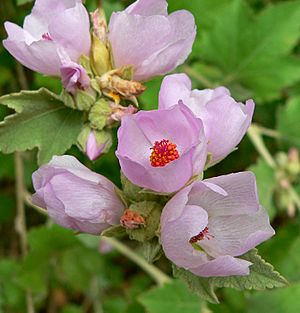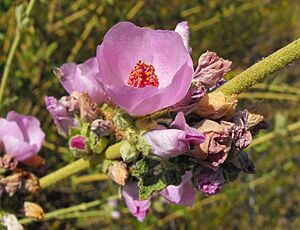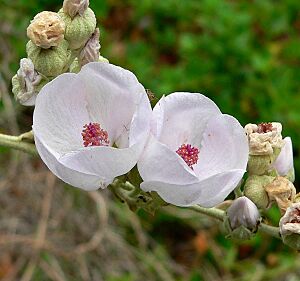Malacothamnus fasciculatus facts for kids
Quick facts for kids Malacothamnus fasciculatus |
|
|---|---|
 |
|
| Scientific classification | |
| Genus: |
Malacothamnus
|
| Species: |
fasciculatus
|
Malacothamnus fasciculatus, also known as the chaparral mallow, is a beautiful flowering plant. It belongs to the mallow family. You can find it growing in the far western parts of North America.
Where It Lives
This plant is native to southern California and northern Baja California in Mexico. It's quite common in areas called chaparral and coastal sage scrub. These are types of plant communities with many shrubs and hardy plants.
What It Looks Like
The chaparral mallow is a shrub. It has a thin stem with many branches. It can grow from about 3 to 16 feet (1 to 5 meters) tall. The plant is covered with soft white or brownish hairs.
Its leaves are shaped like ovals or circles. They are usually 2 to 11 centimeters long. Sometimes, the leaves are divided into smaller sections called lobes. The plant's flowers grow in a long cluster. These flowers are pale pink and their petals are less than a centimeter long.
Different Kinds of Chaparral Mallow
The chaparral mallow is a very diverse plant. Scientists sometimes describe it as having many different varieties. It can sometimes be tricky to tell it apart from other types of Malacothamnus plants.
Here are some of the named varieties:
- Malacothamnus fasciculatus var. catalinensis — This variety is called the Santa Catalina Island bush-mallow. It is found only on Catalina Island. This island is one of the Channel Islands of California.
- Malacothamnus fasciculatus var. fasciculatus — This is the most common variety.
- Malacothamnus fasciculatus var. nesioticus — This is the Santa Cruz Island bush mallow. It is a very rare plant. It is found only on Santa Cruz Island, another one of the Channel Islands. There are only about 120 of these plants left. Because it is so rare, it is listed as an endangered species by the government.
- Malacothamnus fasciculatus var. nuttallii — This variety is found only in California. It grows in the Outer South Coast Ranges and the Western Transverse Ranges.



